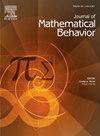探索学生在正弦和余弦函数中的协变推理:动态任务中预期和实际学习轨迹的比较
IF 1.7
Q3 EDUCATION & EDUCATIONAL RESEARCH
引用次数: 0
摘要
本研究通过在基于设计的研究框架内整合动态GeoGebra小程序,探讨高中生如何在三角函数的背景下发展协变推理。在假设学习轨迹(HLT)的指导下,本研究比较了学生在迭代教学周期中从值协调到平滑连续协变的预期推理进展与实际推理表现。对学生任务工件和口头解释的定性分析揭示了参与者之间不同的学习轨迹,强调了任务顺序、明确的脚手架和动态可视化对培养连续推理的重要性。研究结果通过确定差异化支持的关键领域和进一步完善数学教育中的数字干预措施,为教学设计提供了信息。本文章由计算机程序翻译,如有差异,请以英文原文为准。
Exploring students’ covariational reasoning in sine and cosine functions: A comparison of expected and manifested learning trajectories with dynamic tasks
This study investigates how high school students develop covariational reasoning in the context of trigonometric functions by integrating dynamic GeoGebra applets within a design-based research framework. Guided by a Hypothetical Learning Trajectory (HLT), the research compares the expected progression of reasoning—from coordination of values to smooth continuous covariation—with the actual reasoning manifested by students during iterative instructional cycles. Qualitative analyses of students’ task artifacts and verbal explanations reveal distinct learning trajectories among participants, highlighting the importance of task sequencing, explicit scaffolding, and dynamic visualization for fostering continuous reasoning. The findings inform instructional design by identifying key areas for differentiated support and further refinement of digital interventions in mathematics education.
求助全文
通过发布文献求助,成功后即可免费获取论文全文。
去求助
来源期刊

Journal of Mathematical Behavior
EDUCATION & EDUCATIONAL RESEARCH-
CiteScore
2.70
自引率
17.60%
发文量
69
期刊介绍:
The Journal of Mathematical Behavior solicits original research on the learning and teaching of mathematics. We are interested especially in basic research, research that aims to clarify, in detail and depth, how mathematical ideas develop in learners. Over three decades, our experience confirms a founding premise of this journal: that mathematical thinking, hence mathematics learning as a social enterprise, is special. It is special because mathematics is special, both logically and psychologically. Logically, through the way that mathematical ideas and methods have been built, refined and organized for centuries across a range of cultures; and psychologically, through the variety of ways people today, in many walks of life, make sense of mathematics, develop it, make it their own.
 求助内容:
求助内容: 应助结果提醒方式:
应助结果提醒方式:


